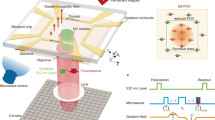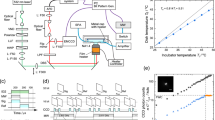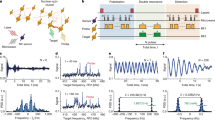Abstract
Magnetic resonance imaging and optical microscopy are key technologies in the life sciences. For microbiological studies, especially of the inner workings of single cells, optical microscopy is normally used because it easily achieves resolution close to the optical wavelength. But in conventional microscopy, diffraction limits the resolution to about half the wavelength. Recently, it was shown that this limit can be partly overcome by nonlinear imaging techniques1,2, but there is still a barrier to reaching the molecular scale. In contrast, in magnetic resonance imaging the spatial resolution is not determined by diffraction; rather, it is limited by magnetic field sensitivity, and so can in principle go well below the optical wavelength. The sensitivity of magnetic resonance imaging has recently been improved enough to image single cells3,4, and magnetic resonance force microscopy5 has succeeded in detecting single electrons6 and small nuclear spin ensembles7. However, this technique currently requires cryogenic temperatures, which limit most potential biological applications8. Alternatively, single-electron spin states can be detected optically9,10, even at room temperature in some systems11,12,13,14. Here we show how magneto-optical spin detection can be used to determine the location of a spin associated with a single nitrogen-vacancy centre in diamond with nanometre resolution under ambient conditions. By placing these nitrogen-vacancy spins in functionalized diamond nanocrystals, biologically specific magnetofluorescent spin markers can be produced. Significantly, we show that this nanometre-scale resolution can be achieved without any probes located closer than typical cell dimensions. Furthermore, we demonstrate the use of a single diamond spin as a scanning probe magnetometer to map nanoscale magnetic field variations. The potential impact of single-spin imaging at room temperature is far-reaching. It could lead to the capability to probe biologically relevant spins in living cells.
This is a preview of subscription content, access via your institution
Access options
Subscribe to this journal
Receive 51 print issues and online access
$199.00 per year
only $3.90 per issue
Buy this article
- Purchase on Springer Link
- Instant access to full article PDF
Prices may be subject to local taxes which are calculated during checkout



Similar content being viewed by others
References
Willig, K. I., Rizzoli, S. O., Westphal, V., Jahn, R. & Hell, S. W. STED microscopy reveals that synaptotagmin remains clustered after synaptic vesicle exocytosis. Nature 440, 935–939 (2006)
Betzig, E. et al. Imaging intracellular fluorescent proteins at nanometer resolution. Science 313, 1642–1645 (2006)
Aguayo, J. B., Blackband, S. J., Schoeniger, J., Mattingly, M. A. & Hintermann, M. Nuclear-magnetic-resonance imaging of a single cell. Nature 322, 190–191 (1986)
Ciobanu, L., Seeber, D. A. & Pennington, C. H. 3D MR microscopy with resolution 3.7 μm by 3.3 μm by 3.3 μm. J. Magn. Reson. 158, 178–182 (2002)
Rugar, D., Yannoni, C. S. & Sidles, J. A. Mechanical detection of magnetic resonance. Nature 360, 563–566 (1992)
Rugar, D., Budakian, R., Mamin, H. J. & Chui, B. W. Single spin detection by magnetic resonance force microscopy. Nature 430, 329–332 (2004)
Mamin, H. J., Poggio, M., Degen, C. L. & Rugar, D. Nuclear magnetic resonance imaging with 90-nm resolution. Nature Nanotechnol. 2, 301–306 (2007)
Glover, P. & Mansfield, P. Limits to magnetic resonance microscopy. Rep. Prog. Phys. 65, 1489–1511 (2002)
Kohler, J. et al. Magnetic resonance of a single molecular spin. Nature 363, 242–244 (1993)
Wrachtrup, J., von Borczyskowski, C., Bernard, J., Orrit, M. & Brown, R. Optical detection of magnetic resonance in a single molecule. Nature 363, 244–245 (1993)
Hanson, R., Dobrovitski, V. V., Feiguin, A. E., Gywat, O. & Awschalom, D. D. Coherent dynamics of a single spin interacting with an adjustable spin bath. Science 320, 352–355 (2008)
Gruber, A. et al. Scanning confocal optical microscopy and magnetic resonance on single defect centers. Science 276, 2012–2014 (1997)
Epstein, R. J., Mendoza, F. M., Kato, Y. K. & Awschalom, D. D. Anisotropic interactions of a single spin and dark-spin spectroscopy in diamond. Nature Phys. 1, 94–98 (2005)
Childress, L. et al. Coherent dynamics of coupled electron and nuclear spin qubits in diamond. Science 314, 281–285 (2006)
Fu, C. C. et al. Characterization and application of single fluorescent nanodiamonds as cellular biomarkers. Proc. Natl Acad. Sci. USA 104, 727–732 (2007)
Liu, K. K., Cheng, C. L., Chang, C. C. & Chao, J. I. Biocompatible and detectable carboxylated nanodiamond on human cell. Nanotechnology 18, 325102 (2007)
Neugart, F. et al. Dynamics of diamond nanoparticles in solution and cells. Nano Lett. 7, 3588–3591 (2007)
Chernobrod, B. M. & Berman, G. P. Spin microscope based on optically detected magnetic resonance. J. Appl. Phys. 97, 014903– (2005)
Kuhn, S., Hettich, C., Schmitt, C., Poizat, J. P. H. & Sandoghdar, V. Diamond colour centres as a nanoscopic light source for scanning near-field optical microscopy. J. Microsc. 202, 2–6 (2001)
Taylor, J. M. et al. High-sensitivity diamond magnetometer with nanoscale resolution. Nature Phys. (in the press); preprint at 〈http://arXiv.org/abs/0805.1367v1〉 (2008)
Gaebel, T. et al. Room-temperature coherent coupling of single spins in diamond. Nature Phys. 2, 408–413 (2006)
Maze, J. R. et al. Nanoscale magnetic sensing with an individual electronic spin in diamond. Nature 10.1038/nature07279 (this issue)
Acknowledgements
We thank M. D. Lukin for drawing our attention to advanced echo-based techniques, and R. Kamella for technical assistance. This work was supported by the EU (QAP, EQUIND, NANO4DRUGS, NEDQIT), DFG (SFB/TR21 and FOR730) and Landesstiftung BW.
Author Contributions G.B., I.Y.C, R.K., M.A.-H., J.T., C.S., C.K., A.W., J.W. and F.J. performed the experiments; A.K. prepared diamond nanocrystals; T.H., A.L. and R.B. prepared magnetic nanostructures; P.R.H., J.W. and F.J. designed and coordinated the experiments; and F.J. wrote the paper. All authors discussed the results, analysed the data and commented on the manuscript.
Author information
Authors and Affiliations
Corresponding author
Supplementary information
Supplementary Figures
This file contains Supplementary Figures S1-S7 with Legends (PDF 1377 kb)
Rights and permissions
About this article
Cite this article
Balasubramanian, G., Chan, I., Kolesov, R. et al. Nanoscale imaging magnetometry with diamond spins under ambient conditions. Nature 455, 648–651 (2008). https://doi.org/10.1038/nature07278
Received:
Accepted:
Issue Date:
DOI: https://doi.org/10.1038/nature07278
This article is cited by
-
High frequency magnetometry with an ensemble of spin qubits in hexagonal boron nitride
npj Quantum Information (2024)
-
Reversible optical data storage below the diffraction limit
Nature Nanotechnology (2024)
-
Use of Hyperfine Structure of Optically Detected Magnetic Resonance Spectrum of a Single NV-Defect in Diamond in Quantum Sensorics of Weak Magnetic Fields
Journal of Applied Spectroscopy (2024)
-
Dopant-assisted stabilization of negatively charged single nitrogen-vacancy centers in phosphorus-doped diamond at low temperatures
npj Quantum Information (2023)
-
Proximity-induced chiral quantum light generation in strain-engineered WSe2/NiPS3 heterostructures
Nature Materials (2023)
Comments
By submitting a comment you agree to abide by our Terms and Community Guidelines. If you find something abusive or that does not comply with our terms or guidelines please flag it as inappropriate.



